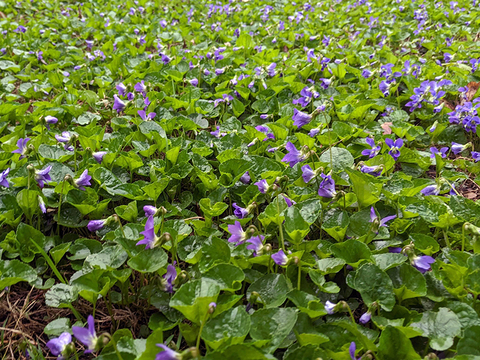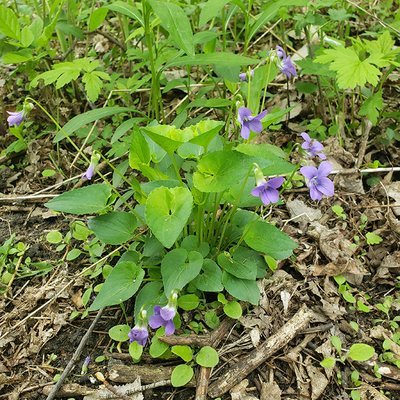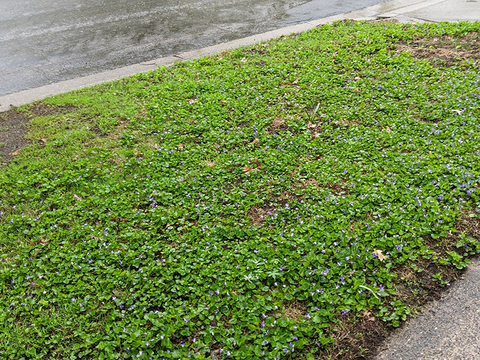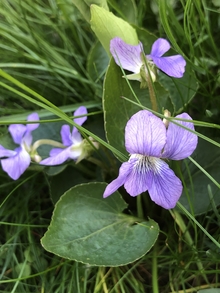Quick facts
- Wild violets are native to Minnesota.
- They spread vigorously by seed and rhizome.
- Seeds explode off small green fruits and are often carried away by ants to feed their larvae.
- Wild violets often require repeated removal efforts due to their waxy leaves and extensive rhizomes.
- Flowers and leaves of wild violets are edible and can be used for medicinal purposes.
Characteristics
Wild violets (Viola sororia or Viola papilionacea), also known as common blue violets, are a native weak perennial ground cover that often forms in clumps between 3 and 10 inches tall.
Wild violets are a member of the violet family (Violaceae) and spread vigorously by rhizomes and seeds.
While sometimes viewed as weedy, wild violets are praised as ground covers in challenging landscapes.
Flowers, fruit and seeds
- Bloom time: spring
- Wild violets have blue-purple flowers with five petals. The petals have dark purple veins towards the center before fading to a white throat.
- Violets have two kinds of flowers: standard blue-purple flowers and small green flowers (fruits) that do not open and self-fertilize.
- Once dried, green fruits open into thirds and are lined with seeds.
- As green fruits dry, seeds explode off the seed pods.
- Seeds are also spread by ants that are attracted to a protein coating.
Leaves
- Wild violet leaves are heart to oval shaped with rounded teeth along the margin.
- Leaves grow alternately with a smooth, waxy surface and hairy underside.
- Waxy leaf surfaces can reduce effective herbicide uptake.
Stem and roots
- Stems can be both smooth and hairy.
- Forms fibrous root systems with rhizomes capable of producing new plants.
- Can form large colonies of plants.
Where it thrives
Wild violets thrive in moist, shaded soils but can grow in a wide range of environments. Wild violets also thrive in soils with high levels of organic matter, such as forest floors and wooded areas.
Throughout history, farmers have used wild violet as an indicator of high soil fertility levels.
Although deer tend to avoid eating wild violets, birds and other mammals will browse them.
Control and management
Wild violets often require repeated removal efforts from a lawn or garden. Many gardeners appreciate their showy flowers and ability to grow in understories and difficult terrain.
Extensive rhizome formation and waxy leaves can reduce herbicide effectiveness.
Turf
- Hand removal is effective for removing small patches but may need to be repeated.
- Remove all parts of the roots and rhizomes to prevent regrowth.
- A dense and healthy turf is the best defense against wild violet encroachment.
- Wild violets will adapt and grow shorter in height to survive mowing.
- Apply herbicides in the early spring or late summer.
- Pre-emergent herbicides do not work well.
- Effective post-emergent herbicides include:
- Triclopyr is often the most effective.
- 2,4-D, 2,4-DP, MCPP, MCPA, dicamba, carfentrazone, sulfentrazone, and quinclorac can also offer some control.
Garden
- Hand removal is effective for removing small patches but may need to be repeated.
- Remove all parts of the roots and rhizomes to prevent regrowth.
- Herbicides may require repeat application due to wild violet leaves’ waxy surface and their extensive rhizomes.
- Non-selective post-emergent herbicides such as glyphosate may be effective with repeat applications.
- Glyphosate can damage desired plants.
Benefits to the landscape
Wild violets provide a source of pollination for many native bees and flies and are a preferred egg-laying host for many fritillary butterflies. The early blooms of wild violets can provide nectar and pollen to many different bees when other plants are not available.
Along with common pollinators, wild violets can attract birds and ants. Wild violet seeds have a coating that contains lipids and proteins. Ants are attracted to the coating (elaiosome) and use it to feed their larvae.
Wild violets have been used in understory landscapes where other plants are difficult to grow. While they are effective at spreading as ground cover, violets can also outcompete other plants.
Wild violet is foraged as both an edible and medicinal plant. While the flower is unique and easy to identify, violet leaves can appear similarly to the toxic plant lesser celandine.
Conservation, invasive status and native status
- Native.
- Wild violet is known as waawiye-bagag and is used as an edible and medicinal flower by the Ojibwe people.
Plants that look similar
- Lesser celandine
- Sweet violet (Viola odorata)
- Ground ivy
- Garlic mustard
CAUTION: Mention of a pesticide or use of a pesticide label is for educational purposes only. Always follow the pesticide label directions attached to the pesticide container you are using. Be sure that the area you wish to treat is listed on the label of the pesticide you intend to use. Remember, the label is the law.
Wild edibles: Common blue violets
Wild violets come in over 100 different varieties. Although they all are edible, some are more palatable than others. The common blue violet is the most harvested.
Harvesting wild violet
Beginning foragers should only harvest the flowers of the violet. Leaves are edible but because the leaves are easily confused with other non-edible plants it is important to stick with the sure bet if you are unfamiliar with violets and their look-alikes.
Violet flowers can be used to garnish salads or flavor vinegar and syrup. Pick them fresh for salads or freeze them while you continue to collect enough of the desired quantity for an infused vinegar or syrup recipe.
Confident foragers will find that leaves are great for salads, delicious in soup, or eaten as cooked greens.
CAUTION: Gathering of wild products should be done safely and legally. Never harvest products on roadsides or other locations where pesticides may be used. Be certain you have permission before harvesting wild products. Many products can be harvested on public lands but require a permit or specific use; know the policies for the products you harvest. Always respect private property.
Indigenous philosophy
Wild violet in the Ojibwe language is known as waawiye-bagag referring to the plants' rounded petals and leaves. All plants offer powerful healing properties. Medicinal knowledge must be sought from an elder using proper protocols and earned over time. There must be a relationship between the healer and the medicine being used.
Most plants also offer food; waawiye-bagag is no exception. In the spring not long after the maple sugar harvest, Ojibwe youth and elders would harvest purple petals to fill Makakoon (birch bark containers). Warm water would be added and petals were allowed to steep overnight. The next day sugar snow from the swamps would be brought to camp and the infused water poured over the snow. The original snow cone or slushy is a springtime delight.
— Gary Wyatt, Extension educator, and Shirley Nordrum
Common Blue Violet (Viola sororia). Minnesota Board of Water & Soil Resources. (2017, July). https://bwsr.state.mn.us/sites/default/files/2018-12/July-2017-Snapshots-FeaturedPlant-Common-blue-violet_0.pdf
Common violet. Missouri Department of Conservation. (n.d.). https://mdc.mo.gov/discover-nature/field-guide/common-violet#:~:text=Violet%20flowers%20have%205%20petals,club%2Dshaped%20at%20the%20tips
Nafici, S. (2016, May 13). Weed of the month: Common blue violet. Brooklyn Botanic Garden. https://www.bbg.org/article/weed_of_the_month_common_blue_violet
Wyatt, G., & Nordrum, S. (2021, May 12). Wild edibles: Common blue violets. UMN Extension. https://extension.umn.edu/news/wild-edibles-common-blue-violets
Reviewed in 2024






